NVIDIA’s GeForce GTX 480 and GTX 470: 6 Months Late, Was It Worth the Wait?
by Ryan Smith on March 26, 2010 7:00 PM EST- Posted in
- GPUs
Temperature, Power, & Noise: Hot and Loud, but Not in the Good Way
For all of the gaming and compute performance data we have seen so far, we’ve only seen half of the story. With a 500mm2+ die and a TDP over 200W, there’s a second story to be told about the power, temperature, and noise characteristics of the GTX 400 series.

Starting with idle temperatures, we can quickly see some distinct events among our cards. The top of the chart is occupied solely by AMD’s Radeon 5000 series, whose small die and low idle power usage let these cards idle at very cool temperatures. It’s not until half-way down the chart that we find our first GTX 400 card, with the 470 at 46C. Truth be told we were expecting something a bit better out of it given that its 33W idle is only a few watts over the 5870 and has a fairly large cooler to work with. Farther down the chart is the GTX 480, which is in the over-50 club at 51C idle. This is where NVIDIA has to pay the piper on their die size – even the amazingly low idle clockspeed of 50MHz/core 101MHz/shader 67.5Mhz/RAM isn't enough to drop it any further.

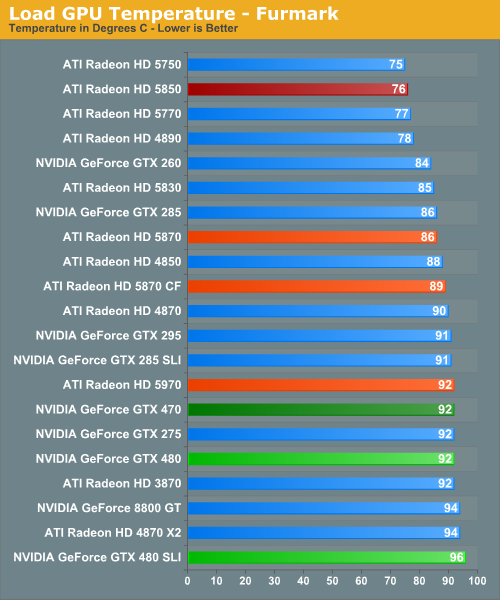
For our load temperatures, we have gone ahead and added Crysis to our temperature testing so that we can see both the worst-case temperatures of FurMark and a more normal gameplay temperature.
At this point the GTX 400 series is in a pretty exclusive club of hot cards – under Crysis the only other single-GPU card above 90C is the 3870, and the GTX 480 SLI is the hottest of any configuration we have tested. Even the dual-GPU cards don’t get quite this hot. In fact it’s quite interesting that unlike FurMark there’s quite a larger spread among card temperatures here, which only makes the GTX 400 series stand out more.
While we’re on the subject of temperatures, we should note that NVIDIA has changed the fan ramp-up behavior from the GTX 200 series. Rather than reacting immediately, the GTX 400 series fans have a ramp-up delay of a few seconds when responding to high temperatures, meaning you’ll actually see those cards get hotter than our sustained temperatures. This won’t have any significant impact on the card, but if you’re like us your eyes will pop out of your head at least once when you see a GTX 480 hitting 98C on FurMark.
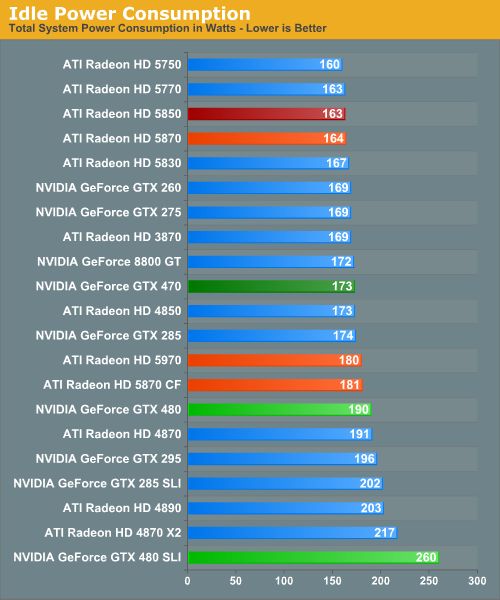
Up next is power consumption. As we’ve already discussed, the GTX 480 and GTX 470 have an idle power consumption of 47W and 33W respectively, putting them out of the running for the least power hungry of the high-end cards. Furthermore the 1200W PSU we switched to for this review has driven up our idle power load a bit, which serves to suppress some of the differences in idle power draw between cards.
With that said the GTX 200 series either does decently or poorly, depending on your point of view. The GTX 480 is below our poorly-idling Radeon 4000 series cards, but well above the 5000 series. Meanwhile the GTX 470 is in the middle of the pack, sharing space with most of the GTX 200 series. The lone outlier here is the GTX 480 SLI. AMD’s power saving mode for Crossfire cards means that the GTX 480 SLI is all alone at a total power draw of 260W when idle.
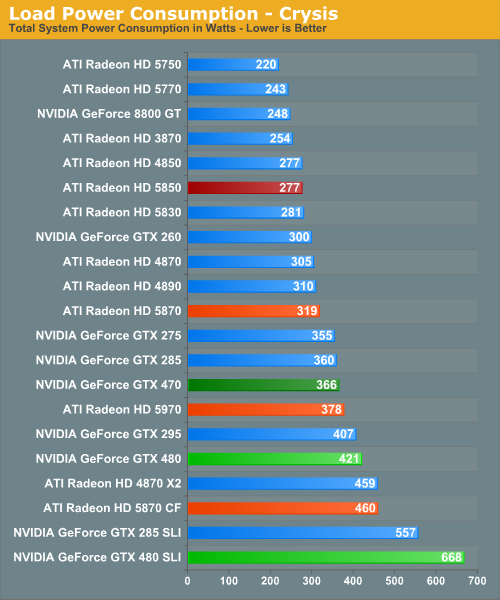
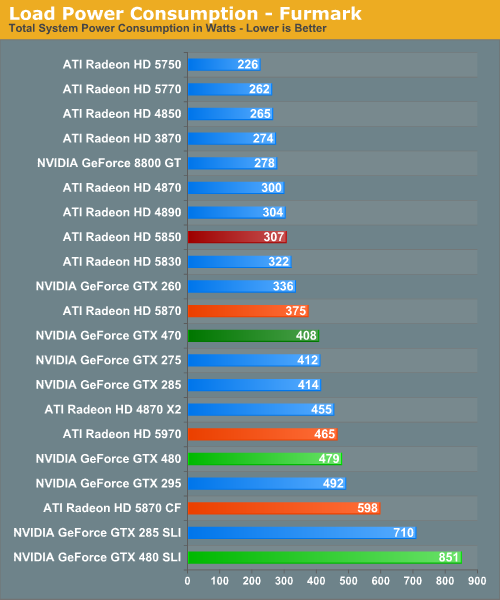
For load power we have Crysis and FurMark, the results of which are quite interesting. Under Crysis not only is the GTX 480 SLI the most demanding card setup as we would expect, but the GTX 480 itself isn’t too far behind. As a single-GPU card it pulls in more power than either the GTX 295 or the Radeon 5970, both of which are dual-GPU cards. Farther up the chart is the GTX 470, which is the 2nd most power draining of our single-GPU cards.
Under FurMark our results change ever so slightly. The GTX 480 manages to get under the GTX 295, while the GTX 470 falls in the middle of the GTX 200 series pack. A special mention goes out to the GTX 480 SLI here, which at 851W under load is the greatest power draw we have ever seen for a pair of GPUs.

Idle noise doesn’t contain any particular surprises since virtually every card can reduce its fan speed to near-silent levels and still stay cool enough. The GTX 400 series is within a few dB of our noise floor here.
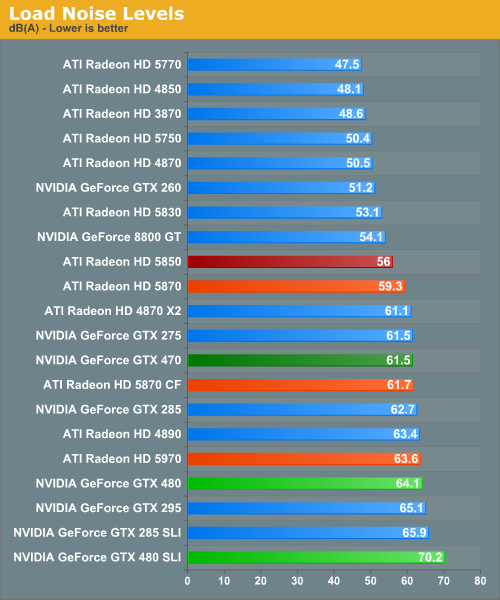
Hot, power hungry things are often loud things, and there are no disappointments here. At 70dB the GTX 480 SLI is the loudest card configuration we have ever tested, while at 64.1dB the GTX 480 is the loudest single-GPU card, beating out even our unreasonably loud 4890. Meanwhile the GTX 470 is in the middle of the pack at 61.5dB, coming in amidst some of our louder single-GPU cards and our dual-GPU cards.
Finally, with this data in hand we went to NVIDIA to ask about the longevity of their cards at these temperatures, as seeing the GTX 480 hitting 94C sustained in a game left us worried. In response NVIDIA told us that they have done significant testing of the cards at high temperatures to validate their longevity, and their models predict a lifetime of years even at temperatures approaching 105C (the throttle point for GF100). Furthermore as they note they have shipped other cards that run roughly this hot such as the GTX 295, and those cards have held up just fine.
At this point we don’t have any reason to doubt NVIDIA’s word on this matter, but with that said this wouldn’t discourage us from taking the appropriate precautions. Heat does impact longevity to some degree – we would strongly consider getting a lifetime warranty for the GTX 480 to hedge our bets.










196 Comments
View All Comments
GTaudiophile - Saturday, March 27, 2010 - link
Me thinks that Cypress really blindsided nVidia. And then on top of it being such an efficient chip, you throw in Eyefinity and all of the audio over HDMI features, etc.Talk about a smack down.
AnnihilatorX - Saturday, March 27, 2010 - link
Page 2:Finally we bad news: availability. This is a paper launch;
simtex - Saturday, March 27, 2010 - link
With the current console generation being the primary focus of game developers I find it hard to believe that tessalation will get the big breakthrough anytime soon. With the next-gen console, it will come, but that is few years from now, and hopefully at that time we have seen at least one new generations of GPUs.viewwin - Saturday, March 27, 2010 - link
I would like a test to see how the new cards do at video encoding.Philip123 - Saturday, March 27, 2010 - link
These things are not "single slot cards" They are double slot. They take 2 slots. No review should be published without pointing out performance per watt. If you dont publish performance per dollar which includes the 100 watt premium over 3 years you are not doing your job. Only and idiot would buy anything from nvdia. You really think anyone is going to want fan noise from these monstrosities anywhere near them?SHAME SHAME SHAME.
Throw this bullshit in the garbage and tell nvidia to f-off untill it releases an actual computer graphics product instead of a spaceheater for retarded monekeys with developmental disablities.
AnnonymousCoward - Saturday, March 27, 2010 - link
You are so wrong.You talk about dual-slot cards as if it's a bad thing--it's the best design currently possible, since it allows for efficient cooling without much fan noise, and the heat goes outside your case. Plus, AMD's 5870 & 5850 are also dual slot!
"No review should be published without pointing out performance per watt" - what gamer cares about that? That's a concern for server farmers!
529th - Saturday, March 27, 2010 - link
I think people would be interested in seeing these cards overclocked, also seeing the 470 in SLIcobra32 - Saturday, March 27, 2010 - link
So Nvidia's fastest card is 11% faster than AMD's mid level card 5870 and AMD's top card the 5970 is allot faster than the 480 GTX. Do not give me that the 5970 is a two chip card and cannot be compared to a single chip card. Sorry guys the 5970 takes up one slot just like the 480 GTX and is faster and consumes less energy to move things on the screen faster. If I got 3 slots on my motherboard I can have 6 video chips with an ATI while with a nvidia setup I can have only 3 at the most. Until Nvidia has a two chip version which looks impossible with this power hunger design. ATI has the top single card, be that two chips, you can buy. It took them 6 months and still cannot buy one paper launches suck. I have bought several Nvidia Cards and like them all but this one really looks to fall short. If I got one slot to put my video card in, ATI has the highest performing Card I can buy 5970. It's like this would I rather have a single core chip or dual core cpu and that's a no brainer two is always better than one.
Roland00 - Saturday, March 27, 2010 - link
Two thingsYou can only have 4 gpus in nvidia or ati multi gpu setups. That means two 5970s not 3. (well you can have 4 gpus and one physX)
Second crossfire doesn't scale well past 2 cards, sli doesn't scale well past 3.
derrida - Saturday, March 27, 2010 - link
Thank you Ryan for including OpenCL benchmarks.